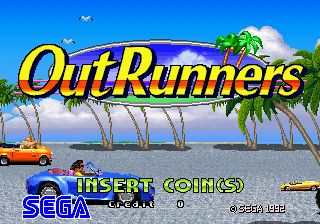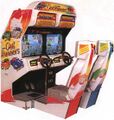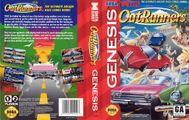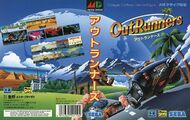Difference between revisions of "OutRunners"
From Sega Retro
Einstein95 (talk | contribs) (→Production Credits: Wow, full names in an arcade game) |
|||
| Line 180: | Line 180: | ||
==Production Credits== | ==Production Credits== | ||
| + | ===Arcade Version=== | ||
| + | '''Planner:''' [[Makoto Sugawara]]<br/> | ||
| + | '''Programmer:''' [[Kazunari Tsukamoto]], [[Hidetoshi Takeshita|Hidetoshi "Wiz" Takeshita]], [[Yoshimi Aikawa]], [[Kazutomo Sanbongi|Kazutomo "Manchi" Sanbongi]]<br/> | ||
| + | '''Designer:''' [[Masaki Kondoh]], [[Taku Makino]], [[Takahiro Ohtsuka]], [[Kazunori Hidaka]], [[Yuiko Aki]], [[Atsushi Shimamura]], [[Tetsu Nakajima]], [[Akira Watanabe]], [[Toshiyuki Mukaiyama]], [[Katsuhisa Satoh]]<br/> | ||
| + | '''Sound Composer:''' [[Takayuki Nakamura]], [[Hiroshi Miyauchi]], [[Takenobu Mitsuyoshi]] | ||
| + | |||
| + | Additionally, the name [[Miyu Tsukamoto]] is present in the ROMs. | ||
| + | |||
===Mega Drive Version=== | ===Mega Drive Version=== | ||
'''Producer:''' [[Ossiy]]<br/> | '''Producer:''' [[Ossiy]]<br/> | ||
Revision as of 18:46, 27 January 2014
| OutRunners | |||||
|---|---|---|---|---|---|
| System(s): Sega System Multi 32, Sega Mega Drive | |||||
| Publisher: Sega, Data East (MD/US) | |||||
| Developer: Sega AM1 | |||||
| Sound driver: SMPS/Z80 | |||||
| Genre: Racing | |||||
| Number of players: 1-4 1-2 | |||||
| |||||
OutRunners (アウトランナーズ) is a sequel to the 1986 Sega classic OutRun and was developed in 1992 and released in early 1993 for the Sega System Multi 32 arcade platform.
Contents
Gameplay
OutRunners follows a similar format to OutRun, in which the player is tasked with driving across the world within a specified amount of time. There are, however, twice as many areas as OutRun in OutRunners, as the world is divided into east and west (selectable after the first stage). Whereas OutRun took place in Europe and Turbo OutRun North America, OutRunners spans the entire globe.
The superior System 32 hardware allow for vastly improved graphics, eight selectable cars (a scrapped plan for the original OutRun) and more music tracks (including those featured in the original OutRun game). It was always distributed as a two player deluxe cabinet (hence the "System Multi 32" name), and it is possible to link two cabinets together to create a four-player racing experience. It was the first OutRun game to allow more than one player to compete at once.
Track Layout
Like the original OutRun, the journey in OutRunners contains many forks in the road, leading to one of ten possible endings. Players all begin at the same location, but are given a choice whether they want to take the eastern or the western routes. Some areas are repeated for both sides, though it is impossible to visit the same location twice in one outing.
| Goal | Stage Number | Goal | ||||||||||
|---|---|---|---|---|---|---|---|---|---|---|---|---|
| 5 | 4 | 3 | 2 | 1 | 0 | 1 | 2 | 3 | 4 | 5 | ||
| A | Northern Europe | Russia | F | |||||||||
| Germany | Germany | |||||||||||
| B | Switzerland | China | Switzerland | China | G | |||||||
| France | Hawaii | Niagara Falls | France | |||||||||
| C | Atlantic Ocean Underwater Tunnel | Japan | San Francisco | Start | Grand Canyon | Atlantic Ocean Underwater Tunnel | Japan | H | ||||
| Mediterranean Sea | Pacific Ocean Crossway Bridge | South America | Mediterranean Sea | |||||||||
| D | Spain | Hong Kong | Spain | Hong Kong | I | |||||||
| Egypt | Egypt | |||||||||||
| E | Kenya | Australia | J | |||||||||
Sequels and Re-Releases
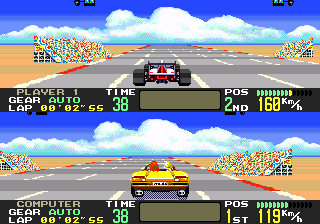
Though it was the most popular game for Sega's Multi 32 hardware, unlike its predecessors OutRunners only received one home console port, to the Sega Mega Drive in 1994. In this port, the screen is split horizontally into two in an attempt to mimic the two screens of the System Multi 32 platform. This, along with the reduced graphics quality and scaled back special effects, meant this version of the game is often the subject to harsh criticism. For some reason, Data East published the game in the US; it was not released in Europe.
There are some slight differences between the Japanese and North American versions. Entering ![]()
![]()
![]()
![]()
![]()
![]()
![]() at the title screen of the Japanese Mega Drive version, selecting arcade mode with
at the title screen of the Japanese Mega Drive version, selecting arcade mode with ![]() and then pressing
and then pressing ![]() allows the user to play as a secret car, "Virtua Formula", otherwise known as the car from Virtua Racing. This option comes complete with a selection of sound effects and music jingles from the game. Whereas the North American option allows you to input the code (and get a confirmation noise), you cannot drive this car.
allows the user to play as a secret car, "Virtua Formula", otherwise known as the car from Virtua Racing. This option comes complete with a selection of sound effects and music jingles from the game. Whereas the North American option allows you to input the code (and get a confirmation noise), you cannot drive this car.
There would not be another OutRun game released until 2003, when OutRun 2 was brought to Sega Chihiro hardware.
Production Credits
Arcade Version
Planner: Makoto Sugawara
Programmer: Kazunari Tsukamoto, Hidetoshi "Wiz" Takeshita, Yoshimi Aikawa, Kazutomo "Manchi" Sanbongi
Designer: Masaki Kondoh, Taku Makino, Takahiro Ohtsuka, Kazunori Hidaka, Yuiko Aki, Atsushi Shimamura, Tetsu Nakajima, Akira Watanabe, Toshiyuki Mukaiyama, Katsuhisa Satoh
Sound Composer: Takayuki Nakamura, Hiroshi Miyauchi, Takenobu Mitsuyoshi
Additionally, the name Miyu Tsukamoto is present in the ROMs.
Mega Drive Version
Producer: Ossiy
Director: JUN Tsu Chi
Planner: Moririn
Programmer: Waka!!, Koba, KenKen
Designer: George, KumoPU, TsuNo.1
Sound Composer: Hata, Milpo, Pomtaro, Shirako
Special Thanks: Sarnin, Miya, Q-Taro, Yosshi, YUI CHAN, Four
Gallery
Physical Scans
System 32 Version
Template:ScanflyerTemplate:ScanflyerTemplate:Scanflyer
Mega Drive Version
| Sega Retro Average | |||||||||||||||||||||||||||||||||||||||||||||||||||||||||||||||||||||||||||||||||||||||||||||||||||||||||||||||||||||||
|---|---|---|---|---|---|---|---|---|---|---|---|---|---|---|---|---|---|---|---|---|---|---|---|---|---|---|---|---|---|---|---|---|---|---|---|---|---|---|---|---|---|---|---|---|---|---|---|---|---|---|---|---|---|---|---|---|---|---|---|---|---|---|---|---|---|---|---|---|---|---|---|---|---|---|---|---|---|---|---|---|---|---|---|---|---|---|---|---|---|---|---|---|---|---|---|---|---|---|---|---|---|---|---|---|---|---|---|---|---|---|---|---|---|---|---|---|---|---|---|
|
| 52 | |
|---|---|
| Based on 23 reviews | |
| Mega Drive, KR |
|---|
|
- ↑ Beep! MegaDrive, "June 1994" (JP; 1994-05-07), page 18
- ↑ Cool Gamer, "9" (RU; 2002-10-13), page 150
- ↑ Computer & Video Games, "August 1994" (UK; 1994-07-15), page 97
- ↑ Digitiser (UK) (1994-07-21)
- ↑ Electronic Games (1992-1995), "July 1994" (US; 1994-0x-xx), page 70
- ↑ Entsiklopediya luchshikh igr Sega. Vypusk 1, "" (RU; 1999-xx-xx), page 346
- ↑ Famitsu, "1994-05-20" (JP; 1994-05-06), page 38
- ↑ Game Players, "Vol. 7 No. 8 August 1994" (US; 1994-0x-xx), page 50
- ↑ GamePro, "August 1994" (US; 1994-xx-xx), page 46
- ↑ Hippon Super, "June 1994" (JP; 1994-04-30), page 62
- ↑ Joypad, "Septembre 1994" (FR; 1994-0x-xx), page 38
- ↑ Mega, "July 1994" (UK; 1994-06-16), page 47
- ↑ Mega Fun, "08/94" (DE; 1994-07-20), page 62
- ↑ MegaTech, "July 1994" (UK; 1994-06-16), page 48
- ↑ Mean Machines Sega, "August 1994" (UK; 1994-06-30), page 64
- ↑ Power Unlimited, "Jaagang 3, Jul/Aug 1995" (NL; 1995-06-28), page 54
- ↑ Sega Pro, "July 1994" (UK; 1994-06-16), page 44
- ↑ Sega Zone, "July 1994" (UK; 1994-06-xx), page 38
- ↑ Sega Mega Drive Review, "1" (RU; 1995-04-03), page 109
- ↑ Sega Saturn Magazine, "September 1995" (JP; 1995-08-08), page 87
- ↑ Tricks 16 bit, "Tricks Sega Gold 800 igr" (RU; 1998-03-20), page 131
- ↑ Video Games, "11/94" (DE; 1994-10-26), page 116
- ↑ VideoGames, "October 1994" (US; 1994-xx-xx), page 74
- 1-4 player games
- 1-2 player games
- Old content rating field
- All games
- Old-style rating (gameplayers)
- Rating without source
- Old-style rating (joypad)
- Rating without PDF source
- Old-style rating (mms)
- Old-style rating (mega)
- Old-style rating (pu)
- Old-style rating (segapro)
- Old-style rating (vgce)
- Update ratings template
- 6 old ratings
- OutRun (franchise)
- System 32 games
- 1992 System 32 games
- System Multi 32 games
- Sega Channel games
